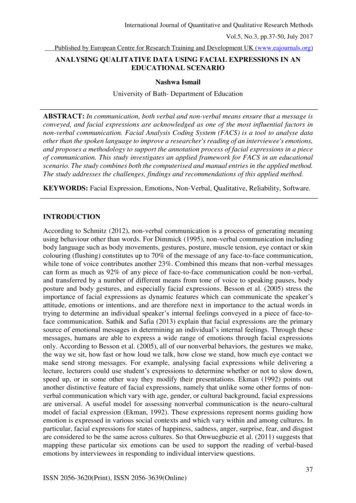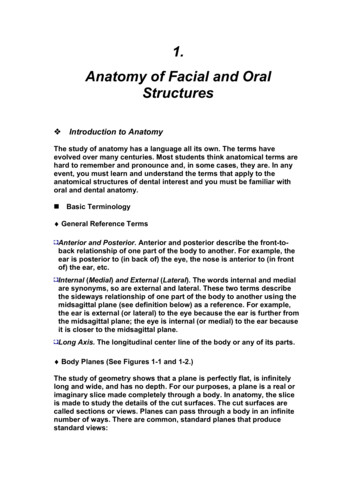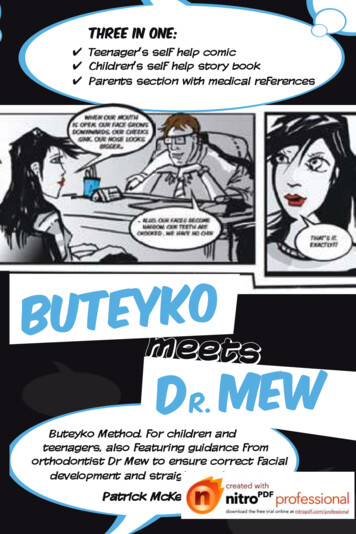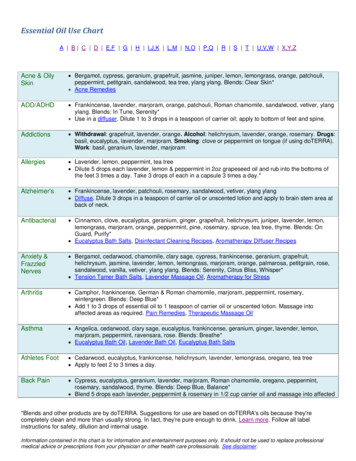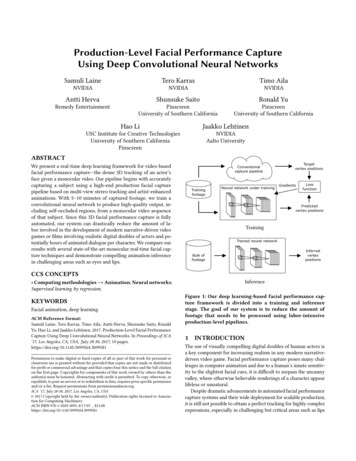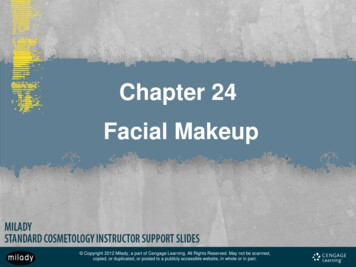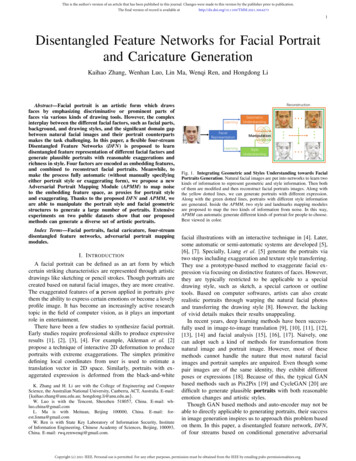
Transcription
This is the author's version of an article that has been published in this journal. Changes were made to this version by the publisher prior to publication.The final version of record is available tangled Feature Networks for Facial Portraitand Caricature GenerationKaihao Zhang, Wenhan Luo, Lin Ma, Wenqi Ren, and Hongdong LiI. I NTRODUCTIONA facial portrait can be defined as an art form by whichcertain striking characteristics are represented through artisticdrawings like sketching or pencil strokes. Though portraits arecreated based on natural facial images, they are more creative.The exaggerated features of a person applied in portraits givethem the ability to express certain emotions or become a lovelyprofile image. It has become an increasingly active researchtopic in the field of computer vision, as it plays an importantrole in entertainment.There have been a few studies to synthesize facial portrait.Early studies require professional skills to produce expressiveresults [1], [2], [3], [4]. For example, Akleman et al. [2]propose a technique of interactive 2D deformation to produceportraits with extreme exaggerations. The simplex primitivedefining local coordinates from user is used to estimate atranslation vector in 2D space. Similarly, portraits with exaggerated expression is deformed from the black-and-whiteK. Zhang and H. Li are with the College of Engineering and ComputerScience, the Australian National University, Canberra, ACT, Australia. E-mail:{kaihao.zhang@anu.edu.au; hongdong.li@anu.edu.au}.W. Luo is with the Tencent, Shenzhen 518057, China. E-mail: whluo.china@gmail.comL. Ma is with Meituan, Beijing 100000, China. E-mail: forest.linma@gmail.comW. Ren is with State Key Laboratory of Information Security, Instituteof Information Engineering, Chinese Academy of Sciences, Beijing, 100093,China. E-mail: nLearning ng Index Terms—Facial portraits, facial caricature, four-streamdisentangled feature networks, adversarial portrait mappingmodules.Reconstruction Abstract—Facial portrait is an artistic form which drawsfaces by emphasizing discriminative or prominent parts offaces via various kinds of drawing tools. However, the complexinterplay between the different facial factors, such as facial parts,background, and drawing styles, and the significant domain gapbetween natural facial images and their portrait counterpartsmakes the task challenging. In this paper, a flexible four-streamDisentangled Feature Networks (DFN) is proposed to learndisentangled feature representation of different facial factors andgenerate plausible portraits with reasonable exaggerations andrichness in style. Four factors are encoded as embedding features,and combined to reconstruct facial portraits. Meanwhile, tomake the process fully automatic (without manually specifyingeither portrait style or exaggerating form), we propose a newAdversarial Portrait Mapping Module (APMM) to map noiseto the embedding feature space, as proxies for portrait styleand exaggerating. Thanks to the proposed DFN and APMM, weare able to manipulate the portrait style and facial geometricstructures to generate a large number of portraits. Extensiveexperiments on two public datasets show that our proposedmethods can generate a diverse set of artistic portraits. Fig. 1. Integrating Geometric and Styles Understanding towards FacialPortraits Generation. Natural facial images are put into networks to learn twokinds of information to represent geometric and style information. Then bothof them are modified and then reconstruct facial portraits images. Along withthe yellow dotted lines, we can generate portraits with different expression.Along with the green dotted lines, portraits with different style informationare generated. Inside the APMM, two style and landmarks mapping modulesare proposed to map the two kinds of information from noise. In this way,APMM can automatic generate different kinds of portrait for people to choose.Best viewed in color.facial illustrations with an interactive technique in [4]. Later,some automatic or semi-automatic systems are developed [5],[6], [7]. Specially, Liang et al. [5] generate the portraits viatwo steps including exaggeration and texture style transferring.They use a prototype-based method to exaggerate facial expression via focusing on distinctive features of faces. However,they are typically restricted to be applicable to a specialdrawing style, such as sketch, a special cartoon or outlinetools. Based on computer softwares, artists can also createrealistic portraits through warping the natural facial photosand transferring the drawing style [8]. However, the lackingof vivid details makes their results unappealing.In recent years, deep learning methods have been successfully used in image-to-image translation [9], [10], [11], [12],[13], [14] and facial analysis [15], [16], [17]. Naively, onecan adopt such a kind of methods for transformation fromnatural image and portrait image. However, most of thesemethods cannot handle the nature that most natural facialimages and portrait samples are unpaired. Even though somepair images are of the same identity, they exhibit differentposes or expressions [18]. Because of this, the typical GANbased methods such as Pix2Pix [19] and CycleGAN [20] aredifficult to generate plausible portraits with both reasonableemotion changes and artistic styles.Though GAN based methods and auto-encoder may not beable to directly applicable to generating portraits, their successin image generation inspires us to approach this problem basedon them. In this paper, a disentangled feature network, DFN,of four streams based on conditional generative adversarialCopyright (c) 2021 IEEE. Personal use is permitted. For any other purposes, permission must be obtained from the IEEE by emailing pubs-permissions@ieee.org.
This is the author's version of an article that has been published in this journal. Changes were made to this version by the publisher prior to publication.The final version of record is available rks [21] is proposed to generate portraits with reasonableemotion changes and artistic styles. In the proposed approach,an input facial image is disentangled into three streams whichinclude face landmarks, prominent facial organs, and facetextures, and then combined to reconstruct the facial image.Similar to traditional conditional GAN models which havean additional condition to guide GAN to generate images,the condition to control drawing styles is extracted fromanother image, i.e., a given portraits, as the fourth stream.The changing of facial parts is controlled by landmarks whichare extracted from the input facial image in the training stage.From the perspective of flexibility, one commonly requiresmore control over the generation of portraits (e.g., changes offacial parts and drawing styles). Our proposed DFN frameworkthus enables to control them via changing the landmarks orproviding different stylizing images.Furthermore, in order to generate diverse portraits morefreely without specifying stylizing image and landmark configurations, two adversarial portraits mapping module, APMM,are proposed to map Gaussian noise to the space of drawingstyles or factors which control the emotion of exaggeration.Different from the traditional auto-encoder framework whichhas one encoder and one decoder, the proposed APMM has oneencoder, one generator, one decoder and one discriminator. Asmentioned above, the artistic style comes from an additionalportrait image. The proposed DFN framework extracts thestyle information contained in this image. After that, the styleinformation is encoded into embedding features, which arethen fed into the decoder to generate the input style. To get ridof the stylizing image, Gaussian noise is input to the generatorto produce features of the same size as the embedding featuresabove. Embedding features from style image and Gaussiannoise are labeled as “real” and “fake”, respectively, whichare then sent into the discriminator. When the generator isable to fool the discriminator so that it fails to distinguishfake embedding from real one, it is endowed the ability ofmapping Gaussian noise into latent space of styles. The fakeembedding features are input into the decoder to producestyle which can be sent into the DFN framework to generateportraits. Likewise, we can also use APMM module to createlandmark configuration to control the changes of emotion.Based on APMM, we finally develop two switches in theDFN framework to control whether the generation is automaticor semi-automatic. As Figure 2 shows, when the style orexaggeration configurations are specified by given images, itis semi-automatic. When the configurations are from APMM,it turns to be automatic. Figure 1 shows the portraits generatedby our proposed method.We have conducted extensive experiments on publicdatasets. Ablation study is also carried out to investigateeffectiveness of different modules in the approach. We alsocompare with existing state-of-the-art methods to verify ourproposed method.Our main contributions are three-fold. We develop a flexible four-stream disentangled featurenetworks, DFN, with each stream specifically controllingone factor of portraits in the process of generation.Through altering different landmarks and style, our DFNframework is able to generate plausible portraits withreasonable changes of facial parts. We propose an APMM module which can map Gaussiannoise into latent space of drawing style and motionchanges, which could help DFN generating portraits withdifferent kinds of style and various motion automatically. Extensive experimental results on public datasets demonstrate the effectiveness of the proposed approach, whichcan generate abundant plausible portraits compared withstate-of-the-art methods.The rest of the paper is organized as follows. Relatedliterature is discussed in Section II. Section III presents theproposed approach. Experimental study results are reported inSection IV. In the end, Section V draws conclusions of thispaper.II. R ELATED W ORKAs our work is related to the specific tasks of portraitgeneration, style transfer, and generative adversarial networks,we discuss the existing studies as follows.A. Portrait GenerationNowadays, many works have been proposed to transfernatural facial images to artistic styles like portrait, cartoonor caricature. The main difference between them is portraitsand cartoons pay more attention to various drawing stylesthan emotion changes, while the caricatures focus on emotionexaggeration. Roughly, these methods can be classified intotwo categories: graphic based methods and deep learningbased methods. Early studies mainly focus on graphic basedsolutions. Some deformation systems for users with expertknowledge and experienced artists are proposed to manipulatephotos interactively [2], [3], [4]. Brennan et al. [7] present anidea of EDFM which defines hand-craft rules to automaticallymodify emotion. Base on this idea, 2D [6], [22], [23] and3D model [24], [8] are proposed to manipulate facial parts.Liang et al. [5] propose a method to learn rules from pairedimages directly based on partial least squares. The deformation capability of them is usually limited because only therepresentation space is shape modeled.Some works try to use warping methods to enhance thespatial variability of neural networks. They first predict transformation parameters based on spatial transformer networks[25], [26] and then warp to obtain the final images. Thesemethods cannot handle local warping because there are notenough global transformation parameters. Others aim to usea dense deformation field [27], which have to predict all thevertices during the warping process.Deep learning methods have been successfully applied tocomputer vision, which pushes researchers to make attemptsto generate artistic images based on convolutional neuralnetworks. Cao et al. [28] propose a framework based onCycleGAN to model facial information and then exaggeratethen via warping methods. Li et al. [29] introduce a weaklypaired training setting to train their proposed CariGAN model.Shi et al. [30] propose a GAN-based framework based onwarping method to automaticaly generate caricature. Liu etCopyright (c) 2021 IEEE. Personal use is permitted. For any other purposes, permission must be obtained from the IEEE by emailing pubs-permissions@ieee.org.
This is the author's version of an article that has been published in this journal. Changes were made to this version by the publisher prior to publication.The final version of record is available athttp://dx.doi.org/10.1109/TMM.2021.30642733L LAE LAD LALNDNENEV 2NormalizationConcatEFLCEV 3EV 1L CAE CADCALSFig. 2. Disentangled Feature Network (DFN). The framework is composed of four streams: landmarks, face texture, prominent face organs, and artistic style.The first three streams are from natural facial image. Facial landmarks are input into CNN layers to obtain embedding features. Based on the facial landmarksand the given natural facial image, facial texture and important facial organs are obtained, which are also input into CNN layers to derive embedding features.These three kinds of features are concatenated and forwarded to an autoencoder architecture to reconstruct the input natural face image. The stylization cuecomes from another caricature image. EV 1 , EV 2 are utilized to extract features of style and content information, which are normalized and input into EF tocreate the final caricature. The black line is the direction of forward flow. The green and blue components are trained and their loss functions are calculatedaccording to the corresponding dashed lines. The orange components are fixed. The green components are trained for the Adversarial Portrait Mapping Module(APMM) in Section III-C. The red bounding boxes show two switches, choosing how the style and landmark streams are configured in the deployment. Onecan specify style and landmarks by providing a caricature image and a specific configuration of landmarks, to generate caricature in a semi-automatic way.One can also switch to connect to the green components (DLA and DCA ) using style and landmark embedding mapped from noise by APMM, to create inan automatic manner.al. generate cartoon images from sketch based on usingconditional generative adversarial networks. In order to changeemotion, Wu et al. [31] introduce a landmark assisted CycleGAN to generate lovely facial images.B. Style TransferEarly methods of style transfer typically rely on low-levelstatistics and often include histogram specification on nonparametric sampling [32], [33]. Given the power of NN-basedmethods to extract features, Gatys et al. [34] for the first timepropose a general method that uses a CNN method to transferthe style from the style image to any image automaticallyby matching features in convolutional layers. However, thismethod is an iterative methods, which requires rounds ofiteration to apply the back propagated gradient to the originalcontent image. This iterative procedure is time-consuming, upto several minutes for one image. To this end, Johnson et al.propose a convolutional network for the image style transfernetwork which requires only a single forward pass for thestyle transfer task by employing the perceptual loss based ona VGG-like network. This single pass network dramaticallyaccelerates the task of style transfer. Then Gatys et al. [35]introduce a new method to control the color, the scale and thespatial location. There is still one limitation of these studies,i.e., for a specific style (given by a style image), a networkis specifically trained for this style, which cannot be used tostylize image to another style. Huang and Belongie [36] thuspropose to develop a network based on instance normalizationto transfer image with arbitrary style. In addition, severalmethods have been proposed by other researchers to improvethe performance [37], [38], [39]. Li et al. [37] develop amethod to enforce local pattern in the deep feature spacebased on Markov Random Field. The application of styletransfer has also extend to videos. Reduer et al. [38] imposetemporal constraints to improve the performance of video styletransfer. However, this approach is also iterative-style onewhich is time-consuming. In light of this, Huang et al. [40]propose to learn a network which stylizes the video frame byframe with single forward pass. To ensure the spatio-temporalconsistency, a constraint that, the motion in terms of opticalflow between two continuous frames before stylization andafter the stylization should be identical, is enforced in thetraining of the network. In inference, real-time performanceis achieved with a single forward pass through the networkand also the spatio-temporal consistency is ensured. Similarly,nearly real-time performance is also achieved by Chen et al. in[41]. Both short-term and long-term consistency are enforcedin their approach.C. Generative Adversarial NetworksThe seminal work [42] introduce the generative adversarialnetworks (GAN) to the community for the generative task. Inthe framework GAN, there are typical two nets, i.e., one is thegenerator and the other one is the discriminator. The generatortries to produce samples which approximate the distribution ofreal data samples. The discriminator distinguishes between thereal samples and the fake samples produced by the generator.With the minmax game between the generator and the discriminator, a equilibrium is achieved and the derived generator isoptimal for the targeted generative task. As a following work,Copyright (c) 2021 IEEE. Personal use is permitted. For any other purposes, permission must be obtained from the IEEE by emailing pubs-permissions@ieee.org.
This is the author's version of an article that has been published in this journal. Changes were made to this version by the publisher prior to publication.The final version of record is available athttp://dx.doi.org/10.1109/TMM.2021.30642734the conditional GAN [21], [43], [44] is proposed to generatevarious samples with different conditions.The paradigm of GAN has inspires many applications [19],[45], [46], [47]. For example, Isola et al. [19] propose aPix2Pix framework to achieve the tasks of photo-label, phototo-map, and sketch-to-photo, under the supervision of pairimages. Zhu et al. [45] introduce a BicycleGAN to ensure thatthe model has the ability to create different outputs. However,these methods require paired samples from two differentdomains, which are expensive to obtain. To this end, CycleGan[20] is proposed by Zhu et al. to alleviate the requirementof paired data. Samples are transformed from one domain tothe other domain, and then transformed back to its originaldomain, and a cycle consistency loss is minimized to makesure a sample is close to its cycle-transformed version. Severalstudies have also been conducted following this strategy, suchas DualGAN [12], DiscoGAN [10], UNIT [11] and DTN [48].Another strategy popularly utilized in GAN is the coarse-tofine one. Multiple stages are composed in the methods likeStackGAN [49] by Zhang et al. and LAPGAN [50] by Dentonet al., to refine the generative results from the previous stage.GAN has also been employed for the video related generationtask such as video prediction [46], [51], [15], video deblurring[52]. These studies achieve surprisingly good performance fortheir specific generation tasks, which motivates us to exploitGenerative Adversarial Networks for portrait generation.III. A PPROACHOur goal is to generate plausible portraits with reasonableemotion manipulation and styles. To achieve this goal, wedisentangle different facial factors of facial images. Thesefactors control the facial emotion and drawing style. Throughmanipulating these factors, we can generate facial portraitswith freedom. Figure 2 shows the process of generation. Asthis figure shows, four factors, facial landmarks, textures,salient face organs, and artistic style are disentangled. In orderto generate portraits with rich drawing styles and variouspatterns, a module called Adversarial Portrait Mapping Model,APMM, is proposed to map noise to embedding features,which can be utilized to replace the real features of style orexaggeration. In this section, we first introduce the method ofdisentangled natural image reconstruction, then discuss howto transfer drawing style. We represent the module of APMM,followed by how the generation is conducted in deployment.A. Disentangled Natural Image ReconstructionWe propose a four-stream network to disentangle facialfactors including the facial landmarks, facial textures, faceorgans, and drawing style. Among these streams, the first threeare utilized in the reconstruction of a given natural face image,which is shown as the upper part (till the EV 2 component) ofFigure 2.Suitable training data is important for increasing the performance of the framework. To train our model, we obtainthe 68 landmark points of a given natural facial image. Wetake them as the input of the first stream. Based on thelandmarks, we wipe away five nuclear parts including eyes,LandmarksTextureOrgansFig. 3. The input of three different streams. We first detect 68 landmarks,shown in the left. Then we extract different parts of natural face image andobtain the middle and right images. The landmarks control the various ofemotion, and the texture and face organs serve as important reference forgeneration.eyebrows, nose, mouth and cheeks, to obtain the stream offacial textures. Then, we create an image which contains onlyprominent organs of eyes, eyebrows, nose and mouth, as thestream of facial organs. These three kinds of streams, as shownin Figure 3, are input into CNN layers to extract features.We concatenate the extracted features and input them intoan encoder-decoder structure to reconstruct the given naturalfacial image. Apart from these components, which are shownin blue, the landmarks are input into an additional U-Netmodel, ELA and DLA , to reconstruct themselves. This U-Netstructure is trained in this stage, but it is prepared for APMMin Section III-C.Network Architecture. Inspired by recent image reconstruction studies, our reconstruction network is based onencoder-decoder architecture like the U-Net [53]. The inputto the upper part of our framework is a RGB image of size244 244 3. A binary landmark image describing thestructure of facial salient points is obtained based on theinput image. By the landmark image, an incomplete RGBimage with some removal regions, and a RGB image whichincludes only some important face organs are derived. Thesetwo images along with the binary landmark image serve asindividual input to three streams of convolutional layers toextract features. The extracted features are then concatenatedas a whole and input into a U-Net network. All convolutionallayers use convolution-BatchNorm-ReLu block with kernelsof 3 3. Skip connections [54], [55] are applied between theconvolutional and deconvolutional layers.Loss Functions. The natural image reconstruction processis optimized with both content loss and adversarial loss.The objective of the adversarial game is to reconstruct animage as realistic as possible to fool a discriminator. Thusthe adversarial loss function can be defined as,La (EN , DN ) Ex,y [logD(x, y)] Ex,l,k [log(1 D(x, DN (EN (x, l, k))))],(1)Copyright (c) 2021 IEEE. Personal use is permitted. For any other purposes, permission must be obtained from the IEEE by emailing pubs-permissions@ieee.org.
This is the author's version of an article that has been published in this journal. Changes were made to this version by the publisher prior to publication.The final version of record is available athttp://dx.doi.org/10.1109/TMM.2021.30642735where x, l and k are the input face texture, landmarks andfacial organ images. y is a real (and complete) image. TheU-Net architecture which includes DN and EN is applied togenerate a realistic facial image, while an additional discriminator D is utilized to distinguish real images from fake images.Namely, DN and EN try to minimize the loss function againstan adversary D which tries to maximize it.In order to push the U-Net architecture to generate imageswhich are close to the ground truth. We use L1 distance,denoted as,LL1 (EN , DN ) y DN (EN (x, l, k)) .(2)The final loss in this part is,LN min max(La (EN , DN ) αLL1 (EN , DN )) . (3)DN ,ENDB. Drawing Style TransferThe bottom stream in Figure 2 shows the pipeline of ourmethod for drawing style transfer. Our style transfer networktakes a drawing style image s and the reconstructed output c ofthe previous section as input, and generates an output portraitswhich contains the content of c and the drawing style of s.In this part, we also use the encoder-decoder architecture,in which the encoder is a fixed VGG-19 [56] model. After thecontent and drawing style images are encoded in latent spaceby the encoder, we feed them to an Instance Normalizationlayer which is used to align the channel-wise mean and variance of content feature to match style features. The traditionalBN layer is originally proposed by [57] to accelerate trainingof CNN models. Radford et al. [58] find that it is also usefulto generate images,BN (c, s) λ(c µ(c)) β.σ(c)(4)where BN normalizes the mean and standard deviation forinput. λ and β are parameters learned from data.In this word, in order to better combine the content andstyle input to generate portraits, the process of computing isemployed as,IN (c, s) σ(s)(c µ(c)) µ(s).σ(c)(5)As such, the normalized content features are scaled with σ(s)and shifted with µ(s). Similar to [59], the σ(s) and µ(s) arecomputed across spatial dimensions for each channel.A decoder EF is built to generate portraits based on theoutput of IN . This model is trained based on the loss functioncomputed by a pre-trained VGG-19 [56] model EV 3 , asL Lc βLs ,(6)where β is a style loss weight, which is utilized to balancethe content loss Lc and drawing style loss Ls . We use theEuclidean distance between the input and generated images tocalculate content loss, which is denoted asLc EV 3 (EF (IN (c, s))) IN (c, s) .(7)The style loss [60] can be calculated as,Ls LX µ(EVi 3 (EF (IN (c, s))) µ(EVi 3 (EF (s)))) 2i 1 σ(EVi 3 (EF (IN (c, s))) σ(EVi 3 (EF (s)))) 2 ,(8)where i indexes layers in the EV 3 model to compute the styleloss. EF (s) represents the feature extracted from the styleimage s by the decoder EF . In this paper, relu1 1, relu2 1,relu3 1, relu4 1 layers are employed in our practice. Weuse the style loss to control the style of generated caricatures.Specially, we use a pre-trained VGG-19 [56] to extract featuresfrom different layers. c and s mean an input batch and theindex of style images.Similar to the top part of DFN, a U-Net architecture, ECAand DCA , is trained to map features of drawing style tolatent space and then transfer them back to the space ofinput. These green parts are also trained in this stage, butprepared for APMM in Section III-C. In summary, We usethe disentangled reconstruction to modify the facial organs. Inorder to generated related realistic images. We use the GANframework to update the parameters of the disentangled featurenetwork. Features captured from the input facial images areencoded by EN and then reconstructed to new facial imagesby DN . We use L1 loss function to train our network even theL2 loss function achieve similar results in my experiments.C. Adversarial Portrait Mapping ModuleIn order to generate caricature with more freedom, wepropose an adversarial portrait mapping module, APMM. Theschematic is shown in Figure 4, which produces learnedfeatures from sole noise. Images can be represented in afeature embedding space, thus we can use the learned featuresto replace the semantic style or emotion encoding during thegeneration process. Some previous works [49], [61] have madeattempts to train another CNN based on the feature representations extracted from a pre-trained model. Our proposedAPMM is inspired by this concept. We firstly train encoderdecoder models to embed features to latent feature space andtransfer them back to the input space. Then a generator istrained to map Gaussian noise to a feature embedding space.We label these mapped features as “fake” and label the featuresextracted from input images as “real”. The discriminator isused to distinguish the real features from fake ones. Whenthe competition between the generator and the discriminatorreaches equilibrium, the mapped features from noise is expected to be alternative of stylization or motion exaggerationfrom specified images. This endows us more freedom togenerate caricatures providing a single natural face image.The training process is shown in Algorithm 1. Both thestyle mapping network and the landmark mapping networkare trained with two steps (steps (1)(3) for style and (2)(4)for landmarks). For each network, the first step is to train theencoder-decoder structure, shown in the green part in Figure 4,to reconstruct the style input or the landmarks. The second stepis conducted to train a generator and a discriminator, shown inCopyright (c) 2021 IEEE. Personal use is permitted. For any other purposes, permission must be obtained from the IEEE by emailing pubs-permissions@ieee.org.
This is the author's version of an article that has been published in this journal. Changes were made to this version by the publisher prior to publication.The final version of record is available ithm 1 The training procedure of APMM(1) Pre-train ECA and DCA Sample n artistic facial images as input y from training set. Extract drawing
another image, i.e., a given portraits, as the fourth stream. The changing of facial parts is controlled by landmarks which are extracted from the input facial image in the training stage. From the perspective of flexibility, one commonly requires more control over the generation of portraits (e.g., chan
